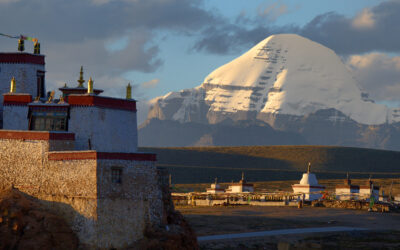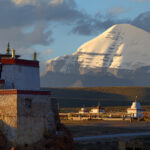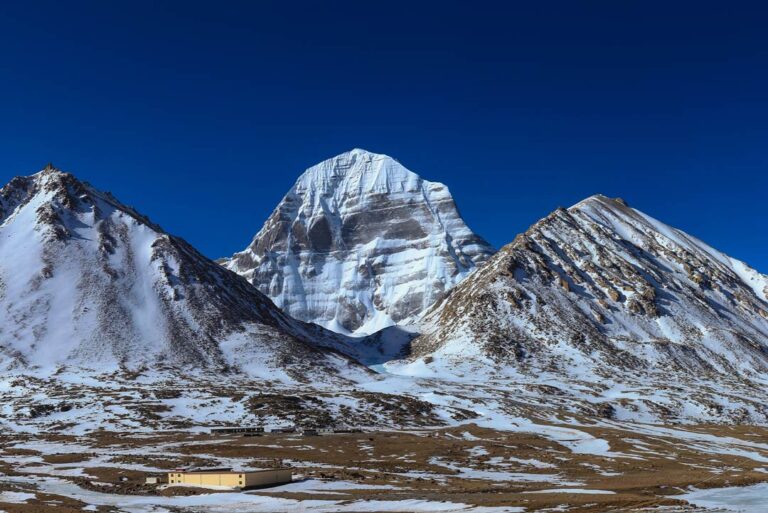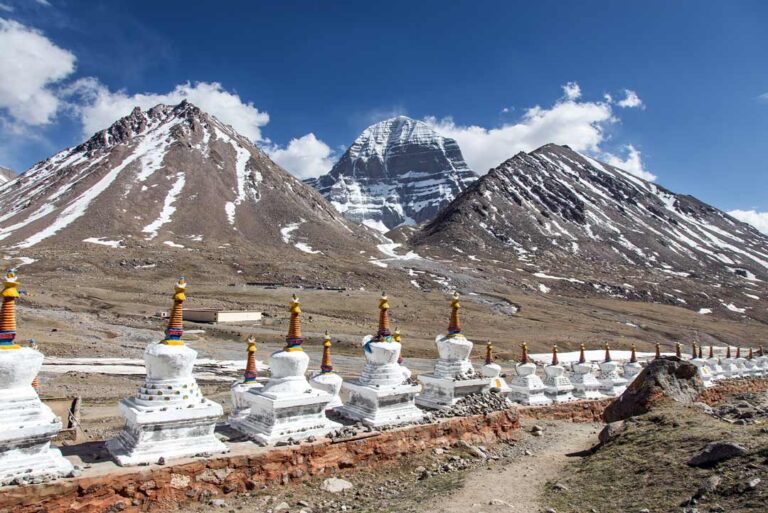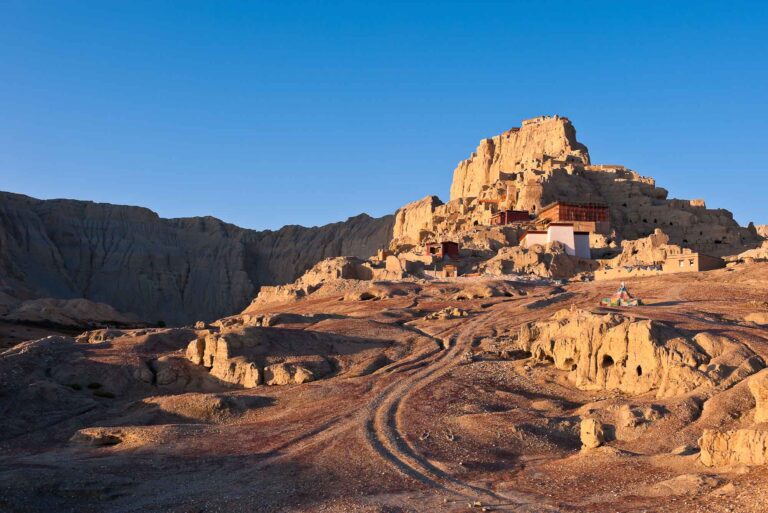The Ruins of Guge Kingdom is nestled in the breathtaking landscapes of Tibet, the Guge Kingdom stands as a testament to a rich and mysterious past. As we embark on the journey to uncover the secrets of this ancient realm, we find a profound connection to the revered Kailash Mansarovar Yatra. Join us as we delve into the historical significance, architectural marvels, and the enigma surrounding the disappearance of the Guge Kingdom.
Historical Significance of the Guge Kingdom
In the 10th century, following the collapse of the Tubo Kingdom, the Guge Kingdom emerged as a powerful force in Tibetan history, marking a transformative era for the region. Established by the great-grandson of Lang Dharma, the founder of the Tubo Kingdom, Guge quickly rose to prominence under the leadership of Jide Nyimagon and his three sons. This dynastic lineage not only solidified Guge’s territorial influence but also paved the way for the establishment of Ladakh and Burang as distinct regimes. The Guge Kingdom, strategically positioned in the western provinces of Tibet, became a cultural epicenter, fostering the dissemination of Buddhist principles and attracting scholars and refugees from across the Tibetan plateau.
The influence of Guge extended far beyond its borders, shaping the social, cultural, and economic fabric of Tibet. Embracing Buddhism, the kingdom played a pivotal role in the propagation of the religion, contributing to the development of diverse philosophical traditions that resonated across the Himalayan region. Guge’s commitment to Buddhist principles not only enriched its own cultural landscape but also established it as a beacon for spiritual seekers and scholars. The kingdom’s cultural legacy, intertwined with the spread of Buddhism, remains an integral part of Tibetan heritage, reflecting the depth of its historical significance.
Geographical Setting and Architecture
Perched atop a majestic yellow hill, the Guge Kingdom’s location, 18 kilometers from Zada country, adds to its allure as a hidden gem in the Tibetan landscape. The strategic placement of the kingdom not only afforded it a commanding view of the surrounding region but also contributed to its mystique, nestled within the natural contours of the land. The elevation of the yellow hill provided both practical and symbolic significance, emphasizing the kingdom’s prominence in the region.
The distinctive three-level construction of the Guge Kingdom stands as a testament to the advanced architectural prowess of its builders. Monasteries strategically occupy the higher reaches, serving as spiritual retreats with panoramic vistas. As one ascends to the pinnacle, golden palaces grace the landscape, a visual spectacle that reflects the kingdom’s grandeur. The seamless integration of these structures with the natural environment, surrounded by soil forests, not only showcases unparalleled craftsmanship but also exemplifies the kingdom’s commitment to harmony between human creation and the wild, further enhancing its architectural magnificence. Exploring the remnants of this intricate construction allows visitors to step back in time and witness the convergence of nature and human ingenuity in the heart of Tibet.
The Mystery of Guge’s Disappearance
The enigmatic disappearance of the Guge Kingdom in 1679 continues to perplex scholars and archaeologists, adding an air of suspense to its rich history. The kingdom, which thrived for centuries, faced an unexpected demise following a war, leaving behind a tapestry of unanswered questions. The abruptness of its end raises intriguing speculations, with historians delving into the annals of time to understand the sequence of events leading to its vanishing act. Some theories suggest internal conflicts or political upheavals, while others contemplate external invasions as potential factors. The scarcity of historical records from that era further intensifies the mystery, creating a historical void that researchers strive to fill. The Guge Kingdom’s disappearance stands as a testament to the fragility of empires and the complexities of historical narratives, urging us to unravel the hidden layers of its final chapter.
Despite meticulous research, the fate of the kingdom’s residents remains elusive. The number of discovered corpses falls significantly short of the estimated population, deepening the intrigue. Natural disasters and plagues, while impactful, seem insufficient to account for the complete evacuation of the kingdom. The lingering questions about where the people went and why they left behind a city of remarkable architecture and cultural significance add an extra layer of fascination. As contemporary explorers and historians venture into the ruins, the enigma of Guge’s disappearance persists, inviting us to ponder the untold stories and lost secrets that echo through the corridors of time.
Cultural and Economic Influence
Guge’s influence in shaping the cultural and economic landscape of Tibet was profound and far-reaching. As a cultural hub, the kingdom embraced and nurtured diverse philosophical traditions, attracting scholars and refugees from various parts of Tibet. The synthesis of these traditions within the Guge Kingdom gave rise to a unique cultural amalgamation, leaving an indelible mark on Tibetan heritage. The flourishing of Buddhism within the kingdom further solidified its cultural significance, with monasteries becoming centers of learning and spiritual enlightenment. Economically, Guge played a pivotal role as a vital trade center due to its strategic location on the banks of the Xiangquang River. This river, flowing from the sacred Lake Manasarovar in the northwest, served as a crucial trade route connecting Tibet with neighboring countries. The kingdom’s prosperity was intertwined with its ability to facilitate trade, allowing for the exchange of goods, ideas, and cultural practices. The economic vitality of Guge not only sustained its own growth but also contributed to the broader economic development of the region. The echoes of this economic and cultural influence still resonate across the Himalayan region, as the Guge Kingdom remains a testament to the interconnectedness of trade, culture, and spirituality in the heart of Tibet.Preservation of Relics
Despite the passage of centuries, the Guge Kingdom’s relics stand as resilient testaments to a bygone era. The golden palaces, intricately designed houses, mysterious caves, and serene monasteries have weathered the ravages of time, offering an unparalleled glimpse into the architectural prowess and historical richness of Tibetan civilization. The meticulous craftsmanship evident in the structures, adorned with intricate carvings and detailed murals, speaks volumes about the cultural sophistication that once flourished within the kingdom. These relics not only serve as tangible artifacts but also as conduits through which visitors can connect with the daily lives, spiritual practices, and artistic expressions of the people who once thrived within the walls of the Guge Kingdom. The halls and monasteries, standing stoically amidst the ruins, act as poignant witnesses to the former prosperity that defined the Guge Kingdom. Each structure echoes with the whispers of ancient prayers, the footsteps of long-gone monks, and the vibrant rituals that once reverberated through the sacred spaces. Exploring these well-preserved sites is akin to stepping back in time, as the relics transport visitors to an era when the Guge Kingdom was at its zenith. The windows of these architectural marvels not only frame the stunning landscapes of Tibet but also open portals to a world where art, spirituality, and daily life converged harmoniously, creating a legacy that endures against the relentless march of time.Landscape and Surroundings
The journey to the Guge Kingdom through Zanda County not only offers a glimpse into the remnants of an ancient civilization but also takes travelers through an extraordinary landscape adorned with soil forests. These once-thriving forests, now silent witnesses to the passage of time, create an immersive experience for visitors. As one traverses through this verdant terrain, it becomes evident that these soil forests were integral to the vibrancy of the Guge Kingdom, providing sustenance and shelter to its residents. The intertwining paths lead explorers towards the heart of the kingdom, where the juxtaposition of nature and ancient history creates a surreal atmosphere, emphasizing the interconnectedness of the Guge Kingdom with its natural surroundings. Moreover, the journey through Zanda County unfolds with awe-inspiring views of Mount Kailash, a sacred site revered by many faiths. The distant silhouette of this majestic peak adds a spiritual dimension to the expedition, inviting contemplation and reflection. Mount Kailash’s significance as a pilgrimage site enhances the overall experience, connecting the historical exploration of the Guge Kingdom with the spiritual aspirations of those on the sacred Kailash Mansarovar Yatra. As travelers ascend through the county, the presence of Mount Kailash becomes more pronounced, casting its benevolent shadow over the Guge Kingdom’s ruins, reinforcing the sanctity of this hidden gem in the Tibetan landscape. The elevated yellow hill, adorned with remnants that tell tales of divinity and history, further enriches the sightseeing experience, making the journey not just a physical exploration but a soul-stirring pilgrimage through time and spirituality.Population and Disappearance Mystery
At its peak, the Guge Kingdom thrived with a bustling population of approximately 100,000 people, making it a vibrant center of cultural and economic activities. The kingdom’s strategic location along trade routes and its cultural significance drew people from various walks of life, contributing to its dynamic and diverse community. However, the mysterious disappearance of this once-thriving population remains one of the most perplexing aspects of Guge’s history. As historians delve into the enigma surrounding the kingdom’s downfall, the absence of a proportional number of discovered corpses raises more questions than answers. The discrepancy between the historical population records and the tangible evidence of remains hints at a complex series of events leading to the kingdom’s demise. Theories abound, ranging from political upheaval to migration, yet the lack of concrete evidence adds to the allure of the Guge Kingdom’s unresolved mysteries. It becomes increasingly clear that a comprehensive understanding of the kingdom’s disappearance requires not only archaeological insights but also a nuanced exploration of the socio-political landscape during that tumultuous period. This lingering sense of intrigue beckons both scholars and visitors alike to unravel the layers of history and seek answers within the silent ruins of the Guge Kingdom.Construction and Harmony with the Environment
The Guge Kingdom’s architectural prowess not only showcases masterful craftsmanship but also reflects a profound spiritual connection with its surroundings. The three-level structure, characterized by monasteries atop the summit and palaces gracing the pinnacle, is a testament to the kingdom’s commitment to religious devotion and peace. As visitors ascend the elevated yellow hill, they are greeted by an awe-inspiring panorama where the monastic structures seem to reach towards the heavens, echoing the spiritual aspirations of the kingdom’s inhabitants. The intentional placement of monasteries in harmony with the natural landscape fosters a serene environment, inviting contemplation and meditation. Moreover, the seamless integration of the Guge Kingdom with the surrounding soil forests adds another layer to its enchanting story. The ruins, embraced by the lush greenery, create a visual spectacle that captivates the imagination. The soil forests, once witnesses to the kingdom’s vibrancy, now stand as guardians of the ancient relics. This harmonious coexistence between man-made structures and nature not only enhances the visual appeal of the site but also underscores the kingdom’s respect for the environment. It’s as if the Guge Kingdom sought to mirror the cyclical nature of life, where the constructed and the natural interweave to create a narrative that transcends the boundaries of time.Guge’s Influence in Ngari Region
Guge’s profound influence reached far beyond its immediate surroundings, rapidly expanding to encompass the entirety of the Ngari region. This expansion was not a mere conquest but a strategic move orchestrated by Jide Nyimagon and his sons, who played pivotal roles in the establishment of three distinct regimes that would leave an indelible mark on the Tibetan landscape. Guge, Ladakh, and Burang emerged as the triumvirate of power, each contributing to the cultural and historical richness of Tibet. As the Guge Kingdom flourished, its influence became synonymous with the cultural identity of the Ngari region, shaping the destiny of these interconnected realms. Jide Nyimagon’s vision and the subsequent establishment of these regimes marked a transformative period in Tibetan history, with Guge at the forefront of this cultural and geopolitical evolution. The flourishing of Guge not only solidified its dominance but also fostered a dynamic cultural exchange that reverberated throughout the Himalayan region. The interplay between these distinct regimes created a historical tapestry, intricately woven with the threads of Guge’s prosperity, cultural contributions, and enduring legacy. Today, the remnants of Guge stand as silent witnesses to an era when the kingdom’s influence radiated across the vast expanse of the Ngari region, leaving an enduring imprint on the historical narrative of Tibet.Cultural Legacy
The Guge Kingdom’s cultural legacy extends far beyond its architectural marvels. As it embraced Buddhism, the kingdom not only became a spiritual center but also a melting pot of diverse philosophical traditions. This inclusive approach attracted refugees from different parts of Tibet, creating a dynamic cultural amalgamation within the walls of Guge. The exchange of ideas and beliefs flourished, leaving an indelible mark on Tibetan heritage. This cultural richness, with its roots deeply embedded in the Guge Kingdom, continues to resonate across the Himalayan region, influencing the practices, rituals, and artistic expressions of the communities that trace their cultural lineage back to this once-mighty empire. The legacy of Guge goes beyond the tangible remnants of its golden palaces; it lives on in the rituals, ceremonies, and artistic expressions that have been passed down through generations. The kingdom’s contributions to Tibetan culture serve as a bridge between the past and the present, reminding contemporary Tibetans and visitors alike of the profound impact of this historical powerhouse. The Guge Kingdom’s enduring cultural legacy is a testament to the transformative power of embracing diversity and fostering an environment where different traditions can coexist and thrive, leaving an everlasting imprint on the spiritual tapestry of the Himalayas.Visiting the Guge Kingdom Today
Accessing the Guge Kingdom involves a journey through Zanda County, a route that not only unveils the historical marvels but also showcases the natural beauty of the region. The soil forests, once witness to the vibrancy of a bygone civilization, now stand as silent sentinels, guiding visitors through a tapestry of greenery. As travelers traverse this path, they are greeted by captivating landscapes that harmonize with the spiritual aura of the Guge Kingdom, creating an immersive experience that transcends time. The remnants of golden palaces, monasteries, and houses that dot the landscape offer more than just visual splendor—they serve as a tangible link to Tibet’s rich past. Exploring these historical treasures provides a firsthand encounter with the architectural prowess of the Tibetan people. The intricate designs, resilient structures, and spiritual symbolism embedded in each relic tell stories of devotion, resilience, and a once-thriving civilization. Visitors have the unique opportunity to study Tibetan architecture in situ, gaining insights into the craftsmanship that shaped the Guge Kingdom. The mystique of this hidden gem extends beyond its ruins, inviting travelers to not just witness history but to be enveloped by it, forging a connection that transcends the boundaries of time and space.The Guge Kingdom Experience
The Guge Kingdom experience transcends the mere observation of ancient ruins; it’s a journey into a realm where time seems to stand still. As visitors traverse the remnants of golden palaces and monastic halls, a profound connection with the past unfolds. The atmosphere is charged with an indescribable energy, creating an ethereal ambiance that invites contemplation and reflection. Every step echoes with the whispers of history, allowing visitors to immerse themselves in the rich tapestry of myths, legends, and the Buddhist legacy that permeates the air. Furthermore, the Guge Kingdom’s unique setting atop the elevated yellow hill, surrounded by soil forests and overlooking the majestic Mount Kailash, amplifies the sensory experience. The panoramic views offer not just a visual feast but a spiritual one, as the landscape becomes a backdrop for the ancient stories that unfold. This immersive encounter with the Guge Kingdom is not confined to its architectural remnants; it extends to the very essence of the land, inviting visitors to absorb the spiritual vibrations and connect with a bygone era. Whether you’re a seasoned history enthusiast or a spiritual seeker embarking on a pilgrimage, the Guge Kingdom stands as a timeless testament to Tibet’s cultural richness and the enduring allure of its mysterious past.Prominence of Guge in Kailash Mansarovar Yatra
The prominence of the Guge Kingdom in the context of the Kailash Mansarovar Yatra is not merely historical; it’s deeply intertwined with the spiritual fabric of the pilgrimage. As pilgrims embark on the sacred journey to Mount Kailash, the Guge Kingdom stands as a poignant reminder of Tibet’s cultural and religious heritage. Its connection to the pilgrimage route adds layers of significance, as the ruins evoke a sense of reverence and contemplation. Pilgrims often pause at the remnants of monasteries and golden palaces, reflecting on the shared spiritual journey that has transcended centuries.
Kailash Yatra Co., a leading agency facilitating the Kailash Mansarovar Yatra in Tibet, recognizes the profound importance of the Guge Kingdom in curating a holistic experience for pilgrims. Beyond being a historical site, the Guge Kingdom becomes a spiritual waypoint on the pilgrimage, offering moments of introspection and connection with the past. The agency organizes guided tours that not only explore the archaeological wonders of the Guge Kingdom but also provide spiritual insights, enriching the overall pilgrimage experience. By acknowledging the spiritual resonance of the Guge Kingdom, Kailash Yatra Co. ensures that pilgrims not only witness the historical grandeur but also immerse themselves in the sacred aura of this mystical realm, making their Kailash Mansarovar Yatra a transformative and spiritually fulfilling journey.
Conclusion
As we conclude our exploration of the Ruins of Guge Kingdom, we are left with a tapestry of history, mystery, and cultural richness. The enigma surrounding its disappearance adds a layer of intrigue, inviting readers to ponder the mysteries of the past. The Guge Kingdom, with its preserved relics and captivating landscapes, remains an integral part of Tibet’s historical legacy.
FAQS
Q: Can the Guge Kingdom be visited throughout the year?
A: The accessibility of the Guge Kingdom depends on seasonal factors, with the best time for visits typically during the warmer months from spring to early autumn. Spring, from March to May, offers mild temperatures, blooming landscapes, and vibrant colors, making it an ideal time for a visit. Summer, extending from June to August, provides warm weather, facilitating exploration without extreme heat. Early autumn, from September to October, is marked by pleasant temperatures and clear skies, enhancing the overall experience. Winter, from November to February, brings colder temperatures, and while the landscape may still be captivating, accessibility might be challenging due to weather conditions. Therefore, planning a visit during the recommended months ensures a more comfortable and enjoyable exploration of the Guge Kingdom’s historical wonders.
Q: What precautions should one take while exploring the Guge Kingdom?
A: While exploring the Guge Kingdom, it’s crucial for visitors to prioritize their comfort and safety. The rugged terrain and varied landscapes warrant the choice of comfortable clothing and sturdy shoes, ensuring ease of movement and protection from uneven surfaces. Given the often challenging weather conditions in the region, including fluctuating temperatures and potential exposure to the elements, dressing in layers is advisable. Carrying an ample supply of water is essential to stay hydrated, especially considering the high altitude. Additionally, out of respect for the cultural and religious significance of the sites within the Guge Kingdom, visitors should adhere to a code of respectful behavior. This includes refraining from disruptive activities, maintaining a quiet demeanor in sacred spaces, and refraining from any behavior that might disturb the sanctity of the historical and religious sites. By adopting these precautions, visitors can enhance their overall experience while ensuring the preservation of the Guge Kingdom’s cultural and spiritual heritage.Q: Is there any ongoing research on the Guge Kingdom’s mysteries?
A: Indeed, the mysteries of the Guge Kingdom persistently captivate the attention of researchers and scholars, prompting ongoing archaeological and historical investigations. These endeavors delve into the enigmatic circumstances surrounding the kingdom’s sudden disappearance after the war in 1679. Teams of archaeologists meticulously excavate the ruins, seeking clues in the meticulously preserved relics and structures that have weathered the passage of centuries. Historical researchers, armed with a thirst for understanding, pore over ancient texts and documents, attempting to piece together the events leading to Guge’s downfall. The collaborative efforts of multidisciplinary teams aim to unlock the secrets hidden within the layers of time, shedding light on the fate of the kingdom’s residents and the factors that contributed to its abrupt end. As technology advances, modern tools such as ground-penetrating radar and 3D mapping contribute to the comprehensive study of the Guge Kingdom’s mysteries, promising new insights into this intriguing chapter of Tibetan history.
How can one book a Kailash Mansarovar Yatra with Kailash Yatra Co.?
A: Embarking on a spiritual pilgrimage to Kailash Mansarovar with Kailash Yatra Co. is a seamless and enriching experience. To book your journey, simply visit their official website, where a user-friendly customer care awaits. Kailash Yatra Co. takes pride in offering comprehensive packages that cater to the diverse needs and preferences of pilgrims. Their website provides detailed information about the itineraries, accommodation options, and other essential details for a hassle-free booking process. From the sacred sites of Guge Kingdom to the revered Mount Kailash, each aspect of the journey is meticulously planned to ensure a spiritually fulfilling and culturally immersive Yatra. Whether you’re a solo traveler or part of a group, Kailash Yatra Co. strives to make your pilgrimage a transformative and memorable experience, aligning with the profound spiritual significance of the Kailash Mansarovar Yatra.

